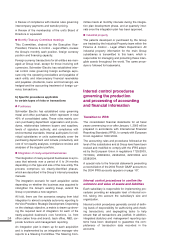APC 2004 Annual Report Download - page 34
Download and view the complete annual report
Please find page 34 of the 2004 APC annual report below. You can navigate through the pages in the report by either clicking on the pages listed below, or by using the keyword search tool below to find specific information within the annual report.
32
5
Internal Control **
To anticipate and control the risks associated with its
operations, as well as the risk of accounting and other
errors and fraud, procedures have been established at
Group level that support the procedures of acquired
entities.
The purpose of these procedures is to:
Ensure that management actions, transactions and
employee behavior are consistent with the overall
business strategy decided by the Board of Directors
of Schneider Electric SA, the Group's parent compa-
ny, that they comply with the applicable laws and reg-
ulations and that they reflect the Group's values and
internal standards and rules.
Obtain assurance that statutory and management
accounting data presented to the Board of Directors
of Schneider Electric SA and Group senior manage-
ment present fairly the sales, results of operations
and financial position of the Group.
No system of internal control designed to fulfill the
above objectives is capable of providing absolute
assurance that the objectives will be met due to the
inherent limitations of procedures, however well con-
ceived.
Internal Control Organization
Key participants
a) ) Board of Directors, Audit Committee and
Remunerations and Appointments Committee
Article L.225-35 of the Commercial Code states that
the Board of Directors is responsible for determining
the Company's business strategy and overseeing its
implementation. In this oversight capacity, the Board
of Directors participates in Schneider Electric's sys-
tem of internal control.
The control exercised by the Board of Directors pri-
marily extends across the following areas:
Implementation of Group strategy. Under the Board's
internal rules limiting the powers of the Chief Executive
Officer, the prior approval of the Board is required for
all material acquisitions, disposals and commitments
(defined as transactions in excess of 100 million).
The annual and interim financial statements, which
are approved or reviewed by the Board of Directors.
Prior to their submission to the Board of Directors, the
financial statements are reviewed by the Audit
Committee, which reports its conclusions to the
Board. The main purpose of the Audit Committee's
review is to obtain assurance as to whether the
accounting policies used are appropriate and have
been applied consistently from one period to the next,
whether transactions that are material at Group level
have been properly accounted for and whether the
rules governing the inclusion of companies in the
scope of consolidation have been properly applied.
The reliability of the internal control system. The
Audit Committee reports to the Board of Directors on
its review of the internal audit organization, programs
and findings, as well as on any examination of finan-
cial or accounting risk management issues performed
at the Committee's own initiative or at the request of
the Board of Directors or the Chairman.
Executive compensation and stock options. The
Remunerations and Appointments Committee makes
recommendations to the Board of Directors concern-
ing the Chairman and Chief Executive Officer's com-
pensation package and on management stock option
plans. The Committee also reports to the Board about
senior management compensation policies applied
within the Group.
b) Senior Management
Group senior management is organized around the
Direction and Strategy Committee and the Operations
Committee.
The Direction and Strategy Committee comprises
Henri Lachmann, Chairman and Chief Executive
Officer, Jean-Pascal Tricoire, Chief Operating Officer,
and the Executive Vice-Presidents in charge of the
Corporate Functions (Finance & Control - Legal Affairs,
Human Resources & Communication and Strategic
Deployment).
The Direction and Strategy Committee regularly
reviews the development outlook of the Group's core
businesses, opportunities for bolt-on acquisitions and
the business case for divestments. It reviews the
Group's overall strategies, its innovation, geographic
expansion and human resources policies and policies
governing relations with research and training estab-
lishments.
The Operations Committee is chaired by Jean-Pascal
Tricoire and comprises the Executive Vice-Presidents
of the North American, European, Asia-Pacific and
International & Iberian Operating Divisions, and the
Executive Vice-Presidents in charge of the three
Corporate Divisions (Customers & Markets, Products
& Technology and Globalization & Industry). The
Executive Vice-Presidents in charge of Finance &
Control - Legal Affairs and Human Resources &
Communication also attend Operations Committee
meetings.
The Operations Committee reviews the profit centers'
business and financial performance at each of its
meetings. It tracks progress on major projects to
improve IT-based management processes and deals
with all issues related to production management,
supply chain optimization and relations with partners
and distributors. It performs ex-post reviews of prod-
uct launches and monitors technological advances
that are likely to be of interest to the Group.
























